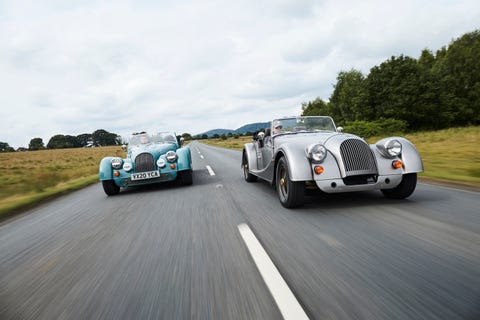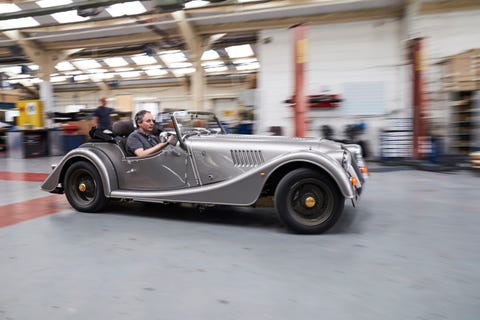Morgan has always moved at a glacial pace compared to the rest of the auto industry. The most English of England’s many sports-car makers has always taken an approach to development that’s more creationist than evolutionary. Which is why, having created its first four-wheeled model in 1936, it kept most of the fundamentals unchanged for the next 84 years.
The dimensions of the steel chassis underneath the car were altered slightly over the years, spreading as humans grew bigger and also to create larger models and accommodate bigger engines. (Morgan has always been agnostic when it comes to powerplants.) The wider and slightly plusher Plus 4 was launched in 1950, and the design of its hand-formed aluminum bodywork of both it and the smaller 4/4 was tweaked and tucked over the years. When technical innovation did arrive at Morgan, it was usually well behind the rest of the auto industry, including both front disc brakes and, ultimately, five-speed manual transmissions.
But the fundamentals remained as if carved in stone. Morgan continued to unite the steel chassis with a framework made from timber, employed solid axles front and rear, using leaf springs at the rear and a sliding-pillar front arrangement. It was an archaic system the rest of the auto industry had let go by the 1950s. Morgan never set out to be old fashioned, but as the world moved on and it stayed in the same place, it never really fought ossification, either. Demand stayed high, and buyers loved the old cars. In those 84 years, Morgan produced 35,000 four-wheeled cars with a steel chassis and exported them to 65 countries.
But everything changes, and now Morgan is moving forward—if not into the 21st century then at least the late 20th. The steel chassis is being replaced by an upgraded development of the bonded aluminum structure accompanied by a switch to turbocharged BMW powerplants. We drove the six-cylinder Plus Six last year, and now the company has launched a Plus Four to replace the Plus 4. The change has been driven by stricter safety standards and the desire to sell cars to those expecting a better-than-Edwardian driving experience. From 10 paces, the new aluminum chassis Plus Four looks almost identical to the Plus 4, but underneath it gets a far stronger bonded structure, control arms at each corner, and a 258-hp turbocharged 2.0-liter four-cylinder from BMW.
The chance to say goodbye to the final Plus 4 took me to Malvern in June. Morgan had just resumed production after a pandemic-necessitated shutdown, and only about half its staff was back at work. The stoppage had also disrupted the transition from the old Plus 4 to the new Plus Four, to the extent the first aluminum chassis cars had overtaken the last of the steel chassis as they worked their way through the factory (which is traditional enough to have become a major tourist attraction in its own right).
But by the simple fact of being in the right place at the right time—standing in the final assembly area as we finished taking pictures and with the car needing to be moved—I received the undeserved honor of driving the final Plus 4 out of the factory for the first time.
There were no bands or fireworks, not even a glass of warm beer to mark the mildly historic occasion. Plus, the car would actually be returning to the workshop later to be fitted with a commemorative plaque signed by all those who worked on it. But from the driver’s seat, it still felt like a small, historical moment. The last steel chassis sits beneath a 70th-anniversary special-edition Plus 4 bought by a collector who lives on the small island of Jersey in the English Channel and who already has an extensive collection of Morgans. He generously agreed to let me experience it for a few miles on local roads before he took delivery.
Malvern is probably the only place on Earth where it is possible to drive a Morgan without pedestrians pointing and rotating about their axis. And even though the local population is used to the sight of the company’s cars being road tested, the experience from inside the cockpit is still novel when compared to anything else. This is what driving used to be like—sitting higher and straighter than in any modern sports car, with legs cramped by a narrow footwell. The windscreen is low and, with the clip-on side screens removed, the vestigial doors are so minimal they’re barely there, with battering airflow and rushing asphalt giving a sense of speed completely out of proportion to your actual velocity. So, 40 mph feels like 60 mph, and by 60 mph—the legal speed limit on a British country road—the Morgan is delivering what would be at least 100-mph worth of sensation from, say, a top-down Miata.
Not that the feedback is particularly well focused. Beyond the sense of speed, messages from the Plus 4’s chassis are either muted or shouted with a crashing ride, noticeable flex over bumps, and frequent shuddering from the part-wooden structure. The unassisted steering is both heavy at low speeds and lacking any useful feel above them, and staying on course requires near constant small inputs of the sort familiar from pre-war black-and-white movies. Given that I was driving a collector’s car that hadn’t yet been collected, my drive was conducted at a respectful pace.
Back at the factory, there’s little sentimentality about the passing of an era, especially as the new Plus Four will still use both the ash-timber frames and hand-beaten aluminum paneling the company is most famous for. One difference that will be welcomed by the production staff is that the alloy-chassis cars have their engines fitted early enough in the build process to be driven between the different workshops of the factory site under their own power. The steel chassis cars had to be rolled.
While the 4/4 and Plus 4 did change throughout their long lives, the last one would have been immediately familiar to those who built the first ones. And if Morgan’s new architecture enjoys a similar lifespan, the company will still be using it in the 22nd century.
The final Plus 4 is going to an ideal home. Jersey’s highest speed limit is 40 mph, something it will make feel faster and more exciting than anything else.
This content is created and maintained by a third party, and imported onto this page to help users provide their email addresses. You may be able to find more information about this and similar content at piano.io



